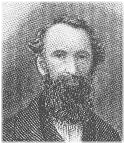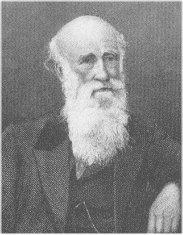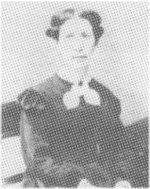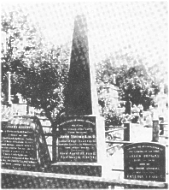|
The Truth In 1847, Dr Thomas, on examining Romans 8:24, noticed that "We are saved by the Hope". He realized that when he was first baptized he had not understood the things which he now knew to be true – the things concerning the Covenants of promise, the Hope of Israel. Convinced now that he had found the Truth and was yet in his sins, the Doctor arranged for a friend to baptize him. "Thus", he said, "after a journey of fourteen years, I had found the truth, which on the ocean I declared I would not rest till I had found". Dr Thomas then issued in the ‘Herald’, a ‘Confession, Abjuration and Declaration’ of the things he now believed. He also traveled to Baltimore, New York, Buffalo and Rochester, preaching the Truth as he went. Tour Of Britain And Publication of "Elpis Israel" In 1848, Dr Thomas with his 12 year old daughter Eusebia, left Richmond for a preaching tour of Britain. The lectures he gave, resulted in the production of ‘Elpis Israel’, ‘Elpis’ meaning ‘the hope of’. This book was funded by subscriptions from some who heard his lectures, and took about four months of concentrated effort for Dr Thomas to complete the manuscript. ‘Elpis Israel’ still published today. As a result of the publication of this book and the lectures, many groups were established in Britain, and according to Dr Thomas, "many who were filled with bitterness against me, are now among my best and firmest friends." While the book was being printed, Dr. Thomas revisited the towns he had preached. When he spoke at Aberdeen, in the audience was a young boy, Robert Roberts. Unknown to both of them at the time, this was the person who was to consolidate the work of Dr. Thomas and establish the ecclesias around the world. In 1850 Dr. Thomas traveled through Holland, Prussia, Germany, Belgium and France then back to Britain. By the time he arrived home in Richmond in November of 1850, he was so "prostrated for six weeks that [his] life was despaired of by some." In 1851, having recovered from his sickness, Dr. Thomas resumed "The Herald" expanding the name to "The Herald of the Kingdom and Age to Come". He conducted two more successful preaching trips that year, the second trip taking him to Halifax, Nova Scotia. Dr. Thomas decided in 1852 to move to New York, and an ecclesia of 8 was established, increasing to over 50 by 1855. In the ‘Herald’ of July 18854, Dr. Thomas announced a new publication: "Anatolia, or Russia Triumphant and Europe Chained". In 1854, he decided to preach in the South West. He first visited Newark in Jersey then to Baltimore, Kentucky, Cincinnati, Lousville. This trip was a journey of 1, 342 miles, during which he had not once changed his clothes since leaving Newark. His next preaching trip was in 1856 and covered a distance of 1080 miles. In 1857 Dr. Thomas’s contact with some Christian Jews in New York, caused him to look more deeply in the Scriptural teaching concerning God and resulted in the publication of ‘Phanerosis’ in 1869 - a book about God-manifestation. 1857 also saw another preaching trip. This time to Massachusetts and Rhode Island. Then with twelve days of his return home, he was off again - to Kentucky, Tennessee and Mississippi, a trip of 3,000 miles. He arrived home feeling very unwell, but 3 weeks later toured Virginia. In 1858, Dr. Thomas again toured Canada then Mississippi, Tennessee and Kentucky. In 1860, he responded from a request in the South of America, and preached there.
The American Civil War Dr. Thomas had been working on an explanation of the book of Revelation for some time. February 1861, saw the first volume of this work published. He called the book ‘Eureka’. This was also the year the American Civil War started. Despite the dangers of traveling to the South, Dr Thomas went to Richmond, the war center of the South, to continue ties in the brotherhood. During his journey he carried a letter from A. B. Magruder, brother of General Jeb Magruder in the Southern army. The General undertook his safe passage under a flag of truce, allowing Dr. Thomas to return to New York three months after departing. The English brethren encouraged Dr. Thomas to visit them, seeing the war in America hampered preaching there. So in a response to an invitation from Robert and Jane Roberts, he went. At the end of this tour, Dr. Thomas suggested Robert Roberts should move to Birmingham and begin a magazine there, to strengthen and support the growing Brotherhood. Roberts took this advice and in 1864, the ‘Ambassador of the Coming Age’ started, shortly afterward having the name changed to ‘The Christadelphian’. Meanwhile, back in America, the Civil War was raising questions on the duty of believers in regard to taking up arms. Should they voluntarily join the forces, or disobey the government’s call to service? Previously in the September 1861 ‘Herald’, Dr. Thomas said "A Christian engaging in, or encouraging war, whether offensive or defensive, does so in open violation of every precept of Christianity …" This was fine until casualties in the North and the South meant conscription was introduced in 1862 in the South and 1863 in the North. However, in both the North and the South, there were means of exemption. Dr. Thomas’ advice was "Citizenship that begins in heaven overrides everything else in its claims and obligations… Our advice to brethren was: "Be not enrolled; go to prison rather … Fear not their threats". Suitable certificates had to be presented to the government to obtain exemption from military service. At that time there was no name to identify them, so Dr. Thomas decided that ‘Brethren in Christ’ described the believers’ true status. It was expressed in the single word, ‘Christadelphians’, Greek for Christ’s brethren. With this new name and the certificates made, Dr Thomas and the applicants went before a Notary Public to "Affirm the genuineness of his signature and the truth of the certificate, in substance and in fact". The County Seal was affixed and the document kept by the brethren in safekeeping until needed. In February 1863, Dr Thomas returned to America and over the next few years he continued preaching and working on the third volume of Eureka. Five years later he traveled back to Britain with his daughter and spent almost two years touring England, Wales and Scotland, holding meetings in private houses and town halls, addressing both small and large audiences. Following the tour, John Thomas planned to settle in Britain with his wife and daughter. He and his daughter first went back to America to wind up his affairs before making the move to England. He attempted another tour of the States and Canada before he was forced to return home with a severe attack of peritonitis, which he had also experienced in Britain. The Death of John Thomas From his home in America, Dr. Thomas continued to write occasional articles for the "Christadelphian" until his death on March 5th, 1871. Dr. Thomas’ daughter, Eusebia Lasius, wrote a letter to the Christadelphians in Britain, conveying the news of his death:
Ellen Thomas later received a letter from Birmingham: "On Sunday morning (19th) we had a very sad meeting. Brother Roberts intimated at the usual interval for fraternal announcements, that he had on the previous day received a letter from Sis. Lasius, announcing her father’s death. He intended to give some particulars, but he could go no further than the opening sentence. His grief was too fresh to be restrained. He sat down to weep, and we all wept with him; in audible sobs, the brethren and sisters gave vent to their unfeigned grief. This painful scene continued for a few moments, when Brother Turner calmly and solemnly invited us to join with him in prayer. This soothed our broken hearts a little, but the exercise was mingled with the manifestations of our sorrow. Afterwards, before the breaking of bread, Brother Roberts spoke at length on the mournful event, and on the as yet unappreciated career of him who now sleeps. He spoke with great difficulty, but his words were suited to the state of our minds, I wish his address could have been taken down for the perusal of those who did not hear it, but the only brother present who could have used shorthand with the necessary celerity (Brother Meahin), was too much bowed down and broken with sorrow to perform the mechanical part. Brother Roberts drew a beautiful parallel between Paul of the first Century and Paul of the nineteenth Century, as he said Bro. Thomas might truly be called."
John Thomas had left clear instructions regarding his burial. He wanted to be buried away from the ground of the Churches, under the control of a Christadelphian brother of good standing. On Monday, March 6th , the funeral was held at the Thomas’ home with a large number of Christadelphians present. The coffin had to be placed in a vault until the spring dried the earth up sufficiently for burial. Robert Roberts traveled to New York and arrived on April 19th. He conducted the final burial in company with forty or fifty brethren, sisters and friends at the Greenwood Cemetery. The tombstone erected over the grave bears the following inscription:
Previous article in this series: Source: "The Life of John Thomas" |



